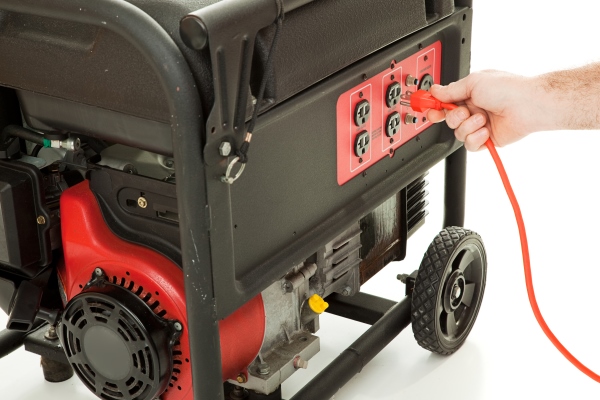Portable Electric Generator Safety

With weather having an impact on electrical service in many parts of our nation, some people are turning to portable electric generators as a source of temporary electricity for their homes. This seeming convenience though, could itself be the source of disaster.
If not properly installed and operated, a portable generator can become a deadly device that kills via electric shock or carbon monoxide fumes. Using a generator indoors can kill you in minutes!
If a portable electric generator is connected to the main electrical supply coming into the house, the electrical generator could feed back into the electric supplier's system and electrocute workers who are repairing the electrical lines. To avoid back-feeding of electricity into utility systems, a homeowner must have a qualified, licensed electrician install a double-pole, double-throw transfer switch between the generator and utility power in compliance with all state and local electrical codes. (A minimum of 10-gauge wiring must be used.) In addition to protecting linemen by ensuring proper wiring, a homeowner should carefully calculate wattage requirements to prevent overloading and damage to appliances and the generator.
Carbon Monoxide Hazards
- Never use a generator in enclosed or partially-enclosed spaces. Generators can produce high levels of carbon monoxide very quickly. When you use a portable generator, remember that you cannot smell or see carbon monoxide. Even if you can't smell exhaust fumes, you may still be exposed to it.
- Never operate your generator in an enclosed or partially enclosed space such as a patio, shed or garage; and when in use, place it far, far away from any structure housing people or pets.
- Most of the serious carbon monoxide poisonings have been caused by generator exhaust fumes drifting into doors, windows, vents and crawl spaces.
- If you start to feel sick, dizzy, or weak while using a generator, get to fresh air right away. Do not delay. The carbon monoxide from generators can rapidly lead to full incapacitation and death.
- If you experience serious symptoms, get medical attention immediately. Inform medical staff that carbon monoxide poisoning is suspected. If you experienced symptoms while indoors, have someone call the fire department to determine when it is safe to re-enter the building.
Follow these safety tips to protect against carbon monoxide poisoning:
- Never use a generator indoors, including in homes, garages, basements, crawl spaces, and other enclosed or partially-enclosed areas, even with ventilation. Opening doors and windows or using fans will not prevent carbon monoxide build-up in the home.
- Follow the instructions that come with your generator. Locate the unit outdoors and away from doors, windows, and vents that could allow carbon monoxide to come indoors.
- Install battery-operated carbon monoxide alarms or plug-in carbon monoxide alarms with battery back-up in your home, according to the manufacturer's installation instructions. The carbon monoxide alarms should be certified to the requirements of the latest safety standards for carbon monoxide alarms (UL 2034, IAS 6-96, or CSA 6.19.01).
- Test your carbon monoxide alarms frequently and replace dead batteries.
Electrical Hazards
Follow these tips to protect against shock and electrocution:
- Keep the generator dry and do not use in rain or wet conditions. To protect from moisture, operate it on a dry surface under an open, canopy-like structure. Make sure your hands are dry before touching the generator.
- Plug appliances directly into the generator. Or, use a heavy duty, outdoor-rated extension cord that is rated (in watts or amps) at least equal to the sum of the connected appliance loads. Check that the entire cord is free of cuts or tears and that the plug has all three prongs, especially a grounding pin.
- Never try to power the house wiring by plugging the generator into a wall outlet, a practice known as "backfeeding." This is an extremely dangerous practice that presents an electrocution risk to utility workers and neighbors served by the same utility transformer. It also bypasses some of the built-in household circuit protection devices.
- If you must connect the generator to the house wiring to power appliances, have a qualified electrician install the appropriate equipment in accordance with local electrical codes. Or, check with your utility company to see if it can install an appropriate power transfer switch.
- For power outages, permanently installed stationary generators are better suited for providing backup power to the home. Even a properly connected portable generator can become overloaded. This may result in overheating or stressing the generator components, possibly leading to a generator failure.
Fire Hazards
- Never store fuel for your generator in the home. Gasoline, propane, kerosene, and other flammable liquids should be stored outside of living areas in properly-labeled, non-glass safety containers.
- Do not store them near a fuel-burning appliance, such as a natural gas water heater in a garage. If the fuel is spilled or the container is not sealed properly, invisible vapors from the fuel can travel along the ground and can be ignited by the appliance's pilot light or by arcs from electric switches in the appliance.
- Before refueling the generator, turn it off and let it cool down. Gasoline spilled on hot engine parts could ignite.